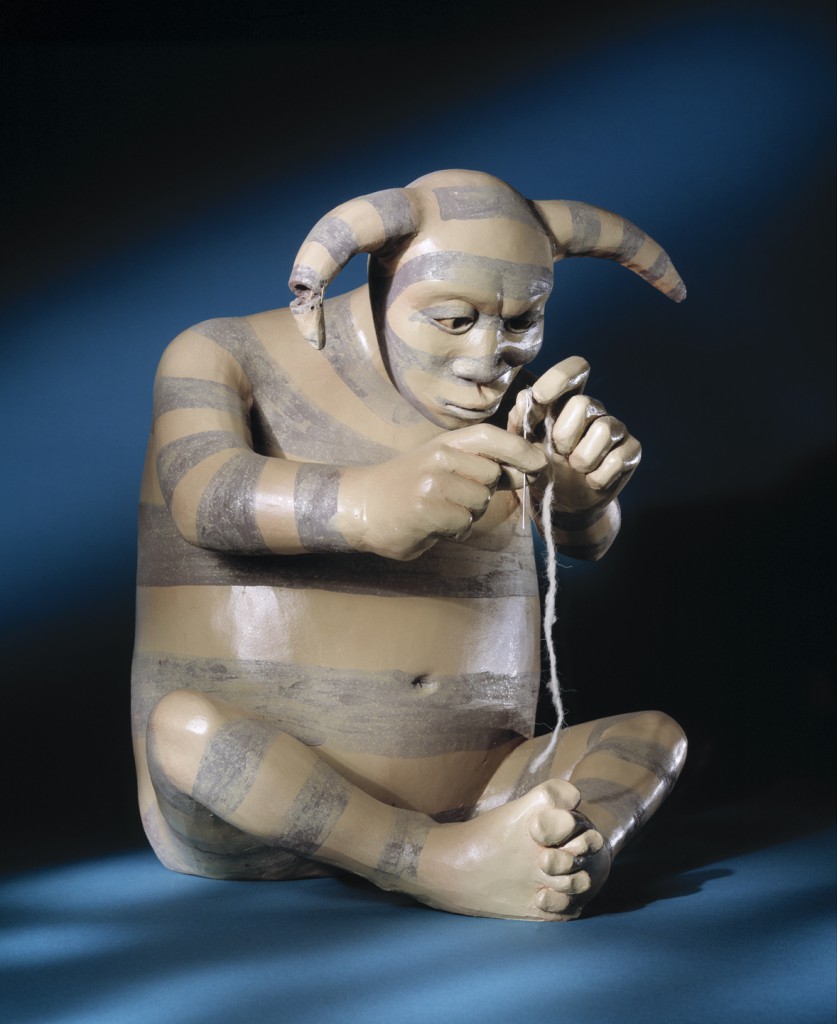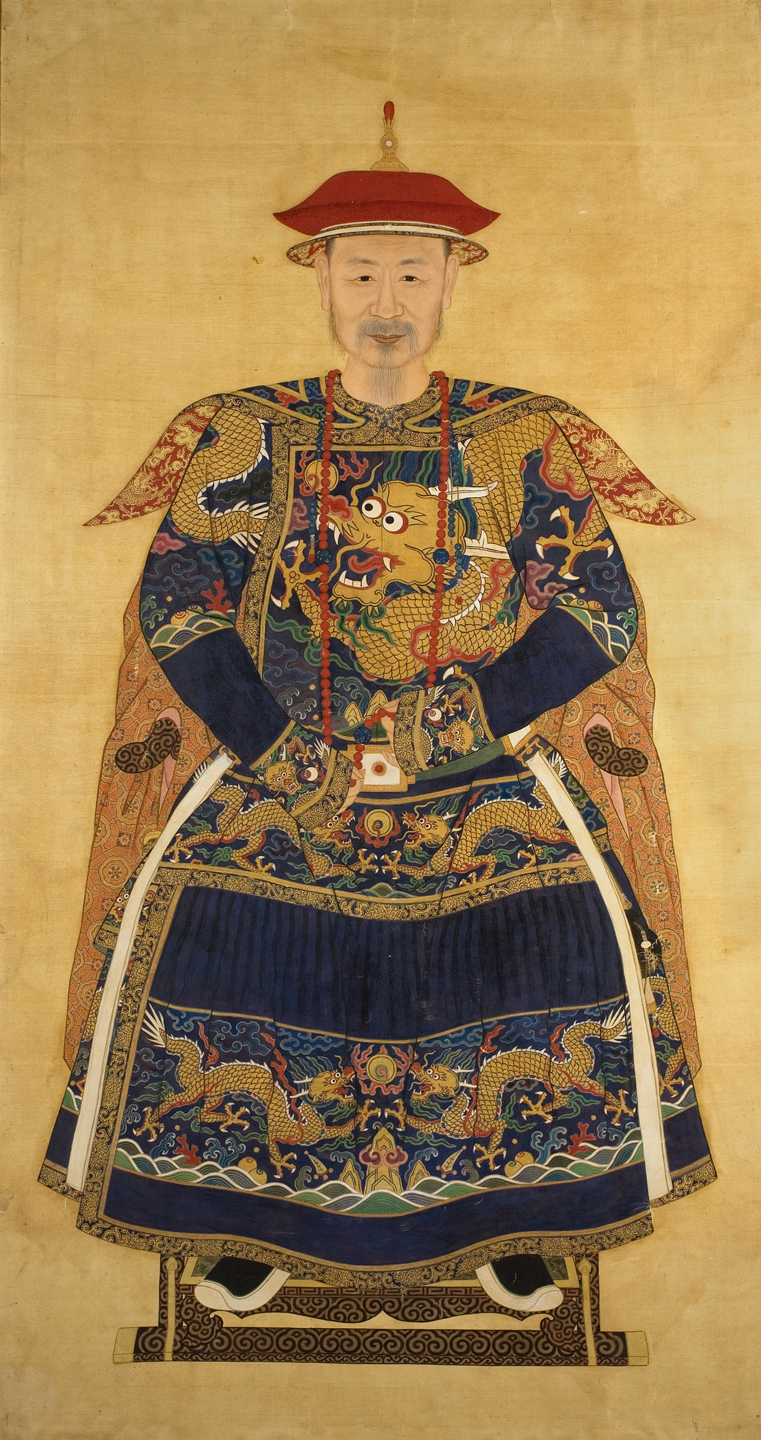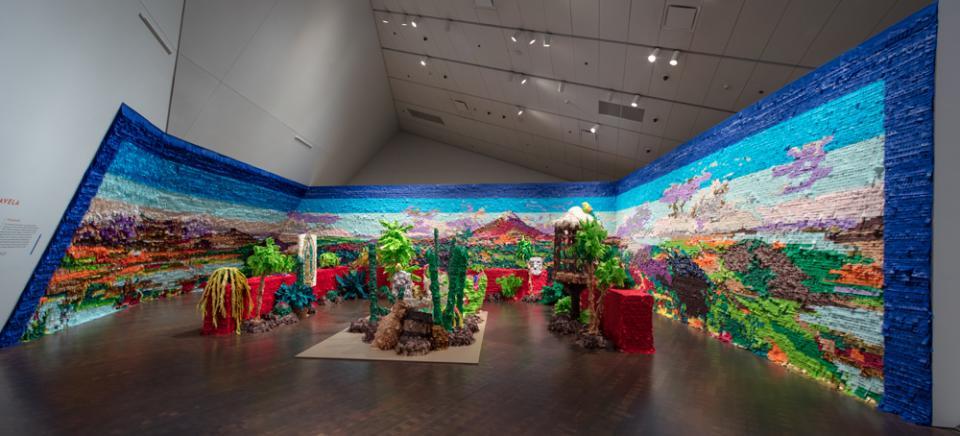Students will learn about The Things I Have to Do to Maintain Myself and what the kosha (the character featured in the sculpture is a kosha) is wearing and why. They will then tour a place they are familiar with, such as their school, and locate where they are on a map of the building. While on the tour they will notice how individuals perform different activities in different places and are sometimes required to wear specific clothing to do their work.
Students will be able to:
- identify locations of familiar places on a map with help from the teacher;
- demonstrate knowledge about location through personal experience, integrating geographic terms with spatial thinking; and
- use pictures to show an understanding of the special requirements of specific environments.
Lesson
- Show students the image of The Things I Have to Do to Maintain Myself. Ask students to describe what they see. Prompt them with the following questions: What is the person in the sculpture doing? How can you tell? What is the person wearing? What kind of job do you think someone who wears this outfit would have? Why do you think this person isn’t wearing shoes? What do you think the weather is like in a place where a person doesn’t need to wear shoes? Does this sculpture remind you of anything you have seen before?
- Explain that this is a sculpture made of clay by Roxanne Swentzell, a member of the Santa Clara Pueblo, which is located in New Mexico. On a map of the United States, point out where New Mexico is located. If possible, ask a student to point to where you are located on the map, and then trace his or her finger over to New Mexico. Does it look like a long way away? Why or why not?
- Tell students that this is a sculpture that portrays a kosha. According to Pueblo belief systems, a kosha is kind of like a clown who teaches humans lessons by imitating them. Discuss what imitating means. Does the outfit look like it belongs to a clown? Why or why not? Share with students the information from the About the Art section in a way that they would understand. The artist, Roxanne Swentzell, says this work is about “all the little things we do to make things possible.”
- We can tell that this kosha is a clown based on his outfit, and his job is to help teach people lessons by imitating them. Show students a map of your school. Point out where different events take place in different rooms, and talk about how people do different jobs to make the school work. Are there any people who wear an outfit that helps them do their job? Take the students on a tour to find out. How about people who work in the cafeteria? Do they wear a special outfit? Ask students to describe it. Why do they think people who work in this space wear a special outfit? Point out where they are on a map of the school and discuss how the environment of the cafeteria is different from their classroom. Now go to the art room. Does the art teacher wear something special to the art room? What about the gymnasium, the custodial space, the principal’s office? Any other places?
- After the tour of the building show students the route you took by pointing to the areas on the map. Have students recount where you went first, next, and last. Remind them of the different people they saw and how the things those people do every day might require them to dress in a certain way.
- Students could choose to draw the outfit of the person they most enjoyed visiting or they could think of someone else who has to dress a certain way to make their job possible, such as a policeman, firefighter, swimmer, etc. Students might also choose to draw a kosha imitating one of these people doing their everyday job. In some cases students might prefer to dress up and pretend to be one of the people they saw.
Materials
- About the Art section on The Things I Have to Do to Maintain Myself (included with the lesson plan)
- Color copies of The Things I Have to Do to Maintain Myself, or the ability to project the image onto a wall or screen
- A United States map for the entire class to see
- A map of your school with rooms labeled
- Paper for drawing
- Crayons or other drawing media
- Optional: Clothes for dress up
Standards
- Social Studies
- History
- Geography
- Recognize change and sequence over time
- Develop spatial understanding, perspectives and connections to the world
- Visual Arts
- Observe and Learn to Comprehend
- Language Arts
- Oral Expression and Listening
- Research and Reasoning
- Collaboration
- Critical Thinking & Reasoning
- Information Literacy
- Invention
- Self-Direction

The Things I Have To Do To Maintain Myself
Height: 15.5 in. Width: 13 in. Depth: 15 in.
Funds from Polly and Mark Addison, 1994.540
Photograph © Denver Art Museum 2009. All Rights Reserved.
Roxanne Swentzell was born in Taos, New Mexico in 1962. Her mother was a potter, writer, and scholar from Santa Clara Pueblo, and her father was a New Jersey native of German descent who was a philosophy professor in Santa Fe. Growing up in Santa Fe, in a household that was filled with clay and artwork, Roxanne took to art-making at an early age. As a child, she struggled to express herself verbally. In order to let others know how she was feeling, she would sculpt small figures that represented her emotions.
Roxanne attributes much of her success to guidance from her family, particularly her mother, Rina, and her uncle, Michael Naranjo, a blind sculptor. From 1978-1980, before graduating high school, she attended the Institute of American Indian Arts.
Today, she spends much of her time at Tower Studio, twelve miles north of Santa Fe. Continuing her interests in nature and preserving the earth, Swentzell founded the Flowering Tree Permaculture Institute, “a research and education organization that relates to permaculture…a way of looking at the world based on the laws of nature.”
Swentzell believes that it is extremely important for her work to have a direct connection with reality. Her art must be a full expression of herself and her experiences and observations of life. She says, “I learned to listen to myself and not be so influenced by what other people wanted me to make. I am going to present the world through my eyes—and not as somebody told me I was supposed to.” She also aims to communicate with all people through her artwork—both Native and non-Native—about the things we share as humans. “With my sculptures I try to reach people’s emotions so they can remember themselves,” says Swentzell.
This sculpture is a representation of a clown, called a kosha in Tewa [TAY-wah], the language of Santa Clara Pueblo. In the Pueblo creation story, the kosha were the first to emerge onto the surface of the earth, climbing up from the underworld and out of the womb of Mother Earth. As they surfaced, each was facing one of the four cardinal directions. The people of the earth followed, dispersing to all parts of the world and becoming the different races. Kosha continue to play a part in Santa Clara ceremonies and stories. One of their main roles is to teach lessons about life. Kosha teach by imitating human behaviors; it is then up to us to recognize when those behaviors are flawed.
This kosha sits deep in concentration, mending his broken ear. With this sculpture, Swentzell references the idea that humans are in a constant state of development. An individual makes choices as he/she creates him/herself. Swentzell is also asking us to consider the importance of a seemingly mundane act. “I like to make the mundane significant, because that’s the way we go throughout days. This piece is about all the little things we do to make things possible. It’s an appreciation of something that’s not always acknowledged,” says Swentzell.
Details
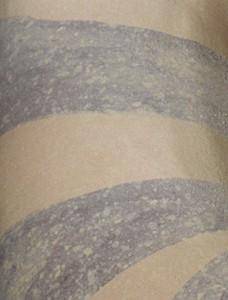
Stripes
The black and white stripes on the body of the kosha represent balance, one of the important life lessons that are taught by kosha.
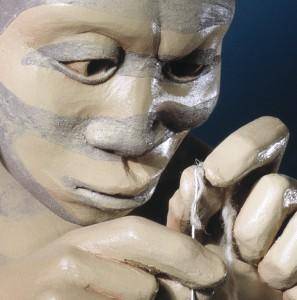
Concentration
The kosha is deep in concentration. Notice how he carefully threads the needle with an extra-thick piece of yarn. His eyes are focused, his lips are pursed, and even his toes are curled tightly together.
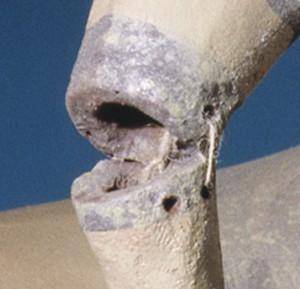
Materials
Swentzell makes her sculptures out of clay, using the techniques of a potter. Unlike other potters in her family, she uses purchased clay, in part due to the large amounts that she uses. She uses coils to create the body and makes cuts where she will add limbs, which are made with coils as well. The body and limbs are hollow, while the toes and fingers are solid. She sculpts the face. The figure must dry for about two weeks before it is ready to be fired in a kiln.
Funding for object education resources provided by a grant from the Morgridge Family Foundation. Additional funding provided by the William Randolph Hearst Endowment for Education Programs, and Xcel Energy Foundation. We thank our colleagues at the University of Denver Morgridge College of Education.
The images on this page are intended for classroom use only and may not be reproduced for other reasons without the permission of the Denver Art Museum. This object may not currently be on display at the museum.
